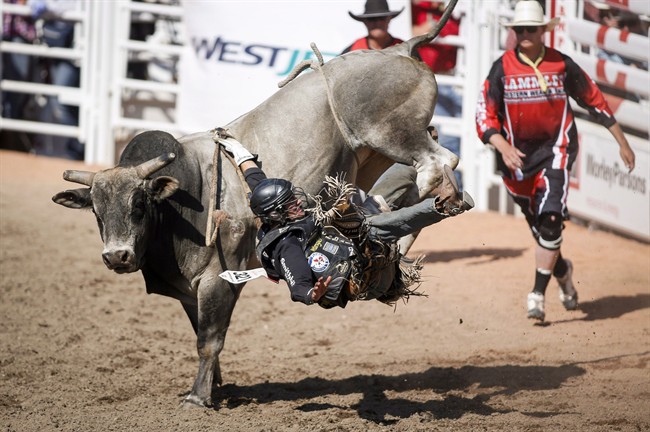When cowboys get in the ring at the Professional Bull Riding (PBR) events in Edmonton this week, concussion awareness will be top of mind.

PBR made helmets mandatory in 2013, but only for younger riders born on or after Oct. 15, 1994.
READ MORE: Friends of Ty Pozzobon say concussions need ‘to be taken more seriously’
In 2012, PBR implemented onsite concussion testing with a specialist and a return-to-competition protocol. If riders show symptoms or fail certain memory and balance tests, they can’t compete again until they pass.
“You do your baseline balancing, memory test and stuff like that, and they go off that baseline when you do get concussed,” professional bull rider Lachlan Richardson said.
PBR officials say in any given season, more than 800 riders will apply for a PBR permit with the intent to compete. However, there are many bull-riding events around the world not monitored or sanctioned by PBR.
“PBR is working with protective equipment manufacturers and suppliers, including helmet manufacturers, to improve the safety equipment available to all bull riders. As appropriate advancements are made in technology, manufacturing processes and other relevant criteria, PBR is committed to evolving its rules to require the use of approved safety equipment at PBR-controlled events to the extent legally possible with respect to independent contractors.”
READ MORE: Scientists found CTE in 99 per cent of donated NFL player brains
Marni Wesner, a University of Alberta sports medicine doctor, says the rules are a good start but need to go further.

Get weekly health news
“Wearing a helmet versus wearing a cowboy hat is a big step forward but it’s not going to actually prevent concussions.
“Helmets don’t actually protect you from concussions. Helmets would decrease the severity of a head injury,” Wesner said.
“It’s not just the being thrown from the bull and getting stomped on, or your head hitting the floor, it’s the head whipping around on a bull — that’s a lot of centrifugal force and rattling around of the brain inside the skull.”
Wesner says there’s no single test that proves someone is concussed. The protocol, she says, also presents some challenges.
“A lot of it is very subjective — reporting of symptoms — and if you don’t tell the truth, there’s no good assessment out of it. I think in that macho culture of sport, they’re not going to ‘fess up that they’re concussed.”
READ MORE: B.C. rodeo star Ty Pozzobon had CTE brain condition when he died
Concussions in the sport of bull riding have been in the spotlight since the death of rider Ty Pozzobon earlier this year.
After a number of documented concussions, Pozzobon took his own life in January.
“Before, we always thought we were tough, but I know we didn’t feel very tough when we lost Ty,” fellow rider Tanner Girletz said on Wednesday.
Researchers found Pozzobon’s brain had chronic traumatic encephalopathy (CTE) from repetitive trauma. It may have led to his depression.
“It changed Ty and who he was,” Girletz said. “I really, truly believe the only reason he did what he did is because he thought he was out of options.”
“It’s kind of opened our eyes [to] see how actually dangerous and life-threatening the sport is.”
More riders are now wearing helmets when they get in the ring.
Girletz, who’s the director of bull riding for the Canadian Finals Rodeo as well as a competitor, says the CFR does not have an official concussion protocol but is working on one.
“It’s kind of our persona as a cowboy. We’re going to be rough and tough. You get knocked down, you’re going to grit your teeth and get back up.”
“It’s a fun, but dangerous way of putting food on the table,” Richardson added. “But it’s what we do and we enjoy doing it.”
READ MORE: Family of pro bull rider Ty Pozzobon to donate his brain for research
The Ty Pozzobon Foundation is trying to establish standardized concussion protocols for rodeo and bull riding athletes.
Professional Bull Riding – Safety Advances by Anonymous TdomnV9OD4 on Scribd




Comments